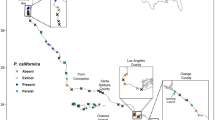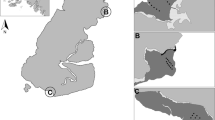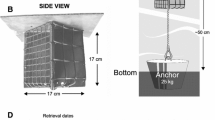Summary
At mid-shore levels on rocky shores in New South Wales, grazing gastropods are the dominant species in sheltered areas. Where wave-exposure is great, barnacles occupy most of the space. At intermediate levels of waveexposure, there are mixtures of grazing gastropods and barnacles, and the patterns of occupancy of space, and structure of the community change from time to time. The major species found in these areas are the coronuloid barnacle Tesseropora rosea, the patellid limpet Cellana tramoserica, the smaller acmaeid limpet, Patelloida latistrigata, which is mostly confined amongst barnacles, and the predatory whelk Morula marginalba. The roles of each of these species in determining the structure and persistence of intertidal communities were investigated by experimental manipulations of the densities of each of these organisms. In most experiments, a range of densities of limpets and barnacles was used, rather than the simple removal of all of one species.
Recruitment of Cellana was negatively associated with increasing density of adult limpets, and with increasing density of barnacles. Growth and survival of juvenile Cellana were decreased by increasing densities of barnacles, probably because barnacles occupied space, preventing limpets from grazing. Morula had no effect on recruitment or survival of juvenile Cellana. Recruitment of juvenile Patelloida was not affected by different densities of barnacles, but survival to adult sizes was poor in areas where whelks are active. In areas where whelks were removed, Patelloida showed increased survivorship with increased cover of barnacles, probably because Patelloida amongst barnacles found refuge from the superior competitive effects of Cellana.
The settlement and subsequent survival of Tesseropora were affected in complex ways by the activities of Cellana. At great densities, Cellana can have deleterious effects on newly-settled barnacles, probably by crushing them whilst grazing. In some areas, and at some densities, however, limpets can have beneficial effects on the recruitment and/or survival of Tesseropora. The limpets graze the juvenile stages of growth of foliose macroalgae, preventing them from growing up to pre-empt the rock-surface (thus preventing settlement of barnacles) or to smother alreadysettled barnacles. The effect of limpets on the recruitment and survival of barnacles in any area is a function of the densities of limpets and barnacles, and the height on the shore and local weather (the latter factors influence the rates of growth of algae).
Increased cover of the rock-surface by adult barnacles caused reductions in the densities of Cellana. Limpets migrated away from areas of great cover of barnacles, and, if confined in such areas, starved and lost weight. The dispersion, as well as the density of the barnacles was important in determining the effects of barnacle cover. Where barnacles occupied half the space, but were scattered, leaving only small patches of bare rock, they had the same deleterious effects on Cellana as in areas where they were spread evenly to occupy most of the rock-surface. Thus, barnacles could invade areas dominated by limpets provided they recruited in sufficient numbers. They did not have to saturate an area to displace the Cellana.
In these communities, all of the species can be considered to have important roles in the establishment and maintenance of community structure. We conclude that interpretations of the roles of individual species must be based on direct, experimental investigation. In this system, there was no indication that many of the species were functionally insignificant.
The present experiments also revealed that the interactions among even a few species are very varied and complex; proper investigation requires considerable replication and repeated experimentation in different places and years.
Finally, although the present studies allow reliable interpretations of observed patterns of occupancy and dominance on natural shores, the experiments did not provide a predictive framework to anticipate the future events in any area. This is because of great variability in the timing and intensity of recruitment of planktonic propagules of all the components in the system, and in the density and activity of predatory whelks in different areas. These results suggest that tightly co-evolved community relationships are not likely to be important, even if they appear to exist, in communities where most of the species have widely dispersed pelagic offspring and interact in diverse and complex ways at different densities.
Similar content being viewed by others
References
Ballantine WJ (1961) A biologically defined exposure scale for the comparative description of rocky shores. Fld Stud. 1:1–19
Barnes H (1955) The growth rate of Balanus balanoides (L.). Oikos 6:109–113
Choat JH (1977) The influence of sessile organisms on the population biology of three species of acmaeid limpets. J Exp Mar Biol Ecol 26:1–26
Connell JH (1961a) The influence of interspecific competition and other factors on the distribution of the barnacle Chthamalus stellatus. Ecology 42:710–723
Connell JH (1961b) The effect of competition, predation by Thais lapillus and other factors on natural populations of the barnacle Balanus balanoides. Ecol Monogr 31:61–104
Connell JH (1970) A predator-prey system in the marine intertidal region. I. Balanus glandula and several predatory species of Thais. Ecol Monogr 40:49–78
Connell JH (1975) Ecology: field experiments in marine ecology. In: R Mariscal (ed.) Experimental marine biology, Academic Press New York p 21–54
Connell JH (1980) Diversity and the coevolution of competitors, or the ghost of competition past. Oikos 35:131–138
Creese RG (1978) Ecology and reproductive biology of intertidal limpets. Unpublished Ph.D. Thesis, University of Sydney
Creese RG (1981). Patterns of growth, longevity and recruitment of intertidal limpets in New South Wales. J Exp Mar Biol Ecol 51:145–171
Creese RG (1982) Distribution and abundance of the acmaeid limpet Patelloida latistrigata, and its interaction with barnacles. Oecologia 52:85–96
Creese RG, Underwood AJ (1982) Analysis of inter- and intraspecific competition amongst intertidal limpets with different methods of feeding. Oecologia 53:337–346
Dakin WJ, Bennett I, Pope E (1948) A study of certain aspects of the intertidal zone of the New South Wales coast. Aust J Scient Res B 1:176–230
Dayton PK (1971) Competition, disturbance and community organization: the provision and subsequent utilization of space in a rocky intertidal community. Ecol Monogr 41:351–389
Dayton PK, Oliver JS (1980) An evaluation of experimental analyses of population and community patterns in benthic marine environments. In: Tenore KR, Coull BC (eds.) Marine benthic dynamics, University of South Carolina Press p 93–120
Denley EJ (1981) Ecology of the intertidal barnacle Tesseropora rosea. Unpublished Ph.D. Thesis, University of Sydney
Denley EJ, Underwood AJ (1979) Experiments on factors influencing settlement, survival and growth of two species of barnacles in New South Wales. J Exp Mar Biol Ecol 36:269–293
Duggins DO (1981) Interspecific facilitation in a guild of benthic marine herbivores. Oecologia 48:157–163
Fairweather PG, Underwood AJ (1983) Bias and the apparent diets of generalist predators. Oecologia (In press)
Frank PW (1969) Growth rates and longevity of some gastropod molluscs on the coral reef at Heron Island. Oecologia 2:232–250
Hatton H (1938) Essais de bionomie explicative sur quelques especes intercotidales d'algues et d'animaux. Ann Inst Oceanogr Monaco 17:241–348
Hawkins SJ (1981) The influence of season and barnacles on the algal colonization of Patella vulgata exclusion areas. J Mar Biol Ass UK 61:1–16
Jernakoff P (1982) Factors affecting the abundance of intertidal macroalgae in areas dominated by barnacles. J Exp Mar Biol Ecol (in press)
Lubchenco J (1978) Plant species diversity in a marine intertidal community: importance of herbivore food preference and algal competitive abilities. Amer Nat 112:23–29
Mackay DA, Underwood AJ (1976) Experimental studies on homing in the intertidal patellid limpet Cellana tramoserica (Sowerby). Oecologia 30:215–238
Menge BA (1976) Organization of the New England rocky intertidal community: role of predation competition and environmental heterogeneity. Ecol Monogr 46:355–393
Menge BA (1978a) Predation intensity in a rocky intertidal community. Relation between predator foraging activity and environmental harshness. Oecologia 34:1–16
Menge BA (1978b) Predation intensity in a rocky intertidal community. Effect of an algal canopy, wave action and desiccation on predator feeding rates. Oecologia 34:17–35
Moran MJ (1980) Ecology and effects on its prey of the intertidal predatory whelk Morula marginalba Blainville. Unpublished Ph.D. Thesis, University of Sydney
Paine RT (1971) A short-term experimental investigation of resource partitioning in a New Zealand intertidal habitat. Ecology 52:1096–1106
Paine RT (1974) Intertidal community structure. Experimental studies on the relationship between a dominant competitor and its principal predator. Oecologia 15:93–120
Paine RT (1977) Controlled manipulations in the marine intertidal zone, and their contributions to ecological theory. In: The changing scenes in natural sciences, 1776–1976. Acad Nat Sci Special Publication 12:245–270
Paine RT (1980) Food webs: linkage, interaction strength and community infrastructure. J Anim Ecol 49:667–685
Southward AJ (1964) Limpet grazing and the control of vegetation on rocky shores. In: Crips DJ (ed) Grazing in terrestrial and marine environments, Blackwell Oxford p 265–273
Sutherland JP (1974) Multiple stable points in natural communities. Am Nat 108:859–873
Sutherland JP, Karlson RH (1977) Development and stability of the fouling community at Beaufort, North Carolina. Ecol Monogr 47:425–446
Underwood AJ (1975) Intertidal zonation of prosobranch gastropods: analysis of densities of four coexisting species. J Exp Mar Biol Ecol 19:197–216
Underwood AJ (1976) Food competition between age-classes in the intertidal neritacean Nerita atramentosa Reeve (Gastropoda: Prosobranchia). J Exp Mar Biol Ecol 23:145–154
Underwood AJ (1978) An experimental evaluation of competition between three species of intertidal prosobranch gastropods. Oecologia 33:185–202
Underwood AJ (1980) The effects of grazing by gastropods and physical factors on the upper limits of distribution of intertidal macroalgae. Oecologia 46:201–213
Underwood AJ (1981) Structure of a rocky intertidal community in New South Wales: patterns of vertical distribution and seasonal changes. J Exp Mar Biol Ecol 51:57–85
Underwood AJ, Denley EJ (1982) Paradigms, explanations and generalizations in models for the structure of intertidal communities on rocky shores. In: Simberloff D, Strong DR Jr (eds) Ecological communities: conceptual issues and the evidence, Princeton University Press (In press)
Underwood AJ, Jernakoff P (1981) Effects of interactions between algae and grazing gastropods in the structure of a low-shore intertidal algal community. Oecologia 48:221–233
Underwood AJ, Jernakoff P (1982) The effects of grazing, tidal height, rock pools and season of the year on the establishment and survival of intertidal macroalgae. (In prep)
Wolff P de (1973) Ecological observations on the mechanisms of dispersal of barnacle larvae during planktonic life and settling. Neth J Sea Res 6:1–129
Author information
Authors and Affiliations
Rights and permissions
About this article
Cite this article
Underwood, A.J., Denley, E.J. & Moran, M.J. Experimental analyses of the structure and dynamics of mid-shore rocky intertidal communities in New South Wales. Oecologia 56, 202–219 (1983). https://doi.org/10.1007/BF00379692
Received:
Issue Date:
DOI: https://doi.org/10.1007/BF00379692




